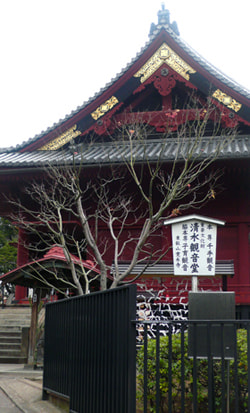
Kiyomizu Kannon-do(Ueno Park)
Q: There is Zojoji Temple that had been the family temple of the shogunate, that is, the Tokugawa family. Why and how was Kan-eiji Temple built here?
Urai: Well, it started in the summer of 1590 when Hideyoshi Toyotomi gave the eight provinces in the Kanto Region to Ieyasu Tokugawa. It was either on August 1 or 2, 1590, depending on records. On the day, Zojoji Temple was designated as the shogunate's family temple in Edo. The following are the reason; The Tokugawa family protected Kogetsuin Temple in the Matsudairago region where eight generations of the Matsudaira family had lived in. Kogetsuin Temple belongs to the Pure Land sect of Buddhism. And there is a big temple called "Daijuji" in Okazaki. This temple also belongs to the Pure Land sect of Buddhism. Ieyasu Tokugawa had believed in the sect, so he designated Zojoji Temple in same sect of Buddhism as the shogunate's family temple. Ieyasu also wanted to build a temple in Edo, which conducts prayers for the Tokugawa family. So Sensoji Temple was designated as the shogunate's "prayer temple." The temple is described as Asakusa Kannon-do in materials from that period. So Zojoji Temple and Sensoji Temple in Edo were the shogunate's family temple and prayer temple respectively. Sensoji Temple was the shogunate's main prayer temple. Tokugawa shoguns and their legitimate wives were enshrined at Zojoji Temple after their death. However, the situation began to change when Ieyasu Tokugawa met Tenkai, a high priest. Then, Hidetada Tokugawa consulted with Tenkai, and built Kan-eiji Temple at the end of 1622. Kan-eiji Temple was a prayer temple that would replace Sensoji Teimple. The shogunate's original prayer temple was Sensoji Temple, but the new prayer temple was built in Ueno as a result of the dialogue between Hidetada and Tenkai. Then, in the course of time, Kan-eiji Temple in Ueno became the main prayer temple in 1680s. So Kan-eiji Temple was not built as the shogunate's family temple, but was built as the prayer temple.
Q: Kan-eiji Temple is also called "Toeizan" in tribute to Hieizan. Does the temple belong to the Tendai sect of Buddhism?
Yes, it is the Tendai sect. Ieyasu Tokugawa had his retainers search prayer and family temples, which belong to the Pure Land sect of Buddhism and the Tendai sect of Buddhism respectively. The retainers found Zojoji Temple for the family temple and Asakusa Kannon-do for the prayer temple. Zojoji Temple and Asakusa Kannon-do belong to the Tendai sect of Buddhism and the Pure Land sect of Buddhism respectively. Then, Ieyasu Tokugawa called the head priests of the two temples during the battle in Odawara, and said, "I decide to designate your temples (as the shogunate's prayer temple and family temple respectively)." These things are recorded in "Kaiun-roku."
Q: Was there something on Ueno Hill before Kan-eiji Temple was built.
I think there were dense woods. However, it is sure that there was Gojotenjin Shrine on top of the Suribachiyama hill, and that a person called Futaba lived in there.(continued in the right column)
Q: Shinto and Buddhism were mixed up in the past?
Yes. There was a mixture of Shinto and Buddhism. Regarding Onoterusaki Shrine, there was an attached temple called Reishoin Temple. However, there is no record that Gojotenjin Shrine had an attached temple. Since Kan-eiji Temple was built on this site, Gojotenjin Shrine was moved to Ueno Hirokoji, and then relocated to the place where Yodobashi-kamera now stands. Then, it moved to Kaya-cho, and finally to the present location after the Great Kanto Earthquake.
Q: When those temples and shrines were built, did they follow examples in Kyoto?
Yes. There was a popular notion called "Mitate," or imitation, since the end of the medieval period. For example, Omi-hakkei, or Eight Views of Omi, is Mitate of Shosho-hakkei, or Eight Views of the Xiao and Xiang Rivers, in China. When colored woodblock prints began to be created, eight views such as Shiba-hakkei, Toto-hakkei and Edo-hakkei were also constructed in Edo. I think those eight views were Mitate of Omi-hakkei. Such Mitate had been popular from the end of the medieval period to the early Edo Period. So, in this way, Tenkai built Kan-eiji Temple in Ueno, imitating Hieizan Enryakuji Temple in Kyoto.
Q: Were Mitate of Kikyomizu-dera Temple in Kyoto and others built here and there?
Those buildings are complete Mitate. This might be the reason why Kan-eiji Temple could not be the shogunate's main prayer temple immediately - this is what I have thought for several years.
I think Tenkai had agreed with the shogunate, Hidetada and Iemitsu that the shogunate's official temple was built as Mitate of Hieizan Enryakuji Temple. However, Tenkai also constructed other buildings, including Kiyomizu-do, Benten-do, Gion-do and a great statue of Buddha, without the shogunate's approval.
I think Tenkai clashed with the shogunate over those buildings.
The shogunate thought that Zojoji Temple and Kan-eiji Temple were the shogunate's family temple and prayer temple respectively and that it was not acceptable to construct other buildings. Since Tenkai built a variety of buildings in the grounds of the shogunate's official temple, Tenkai and the shogunate disagreed with each other over those things. Tenkai's thought might be the following; Even if the shogunate's official temple was built, it was just the temple for the shogunate, and therefore Ueno became a place where commoners did not come to. However, Tenkai wanted to turn Ueno into a pleasure resort where commoners visit. Tenkai thought in that way. Thanks to his idea, Ueno rapidly became a notable site in Edo.(continued in the next page)

Kiyomizu Kannon-do(Ueno Park)














